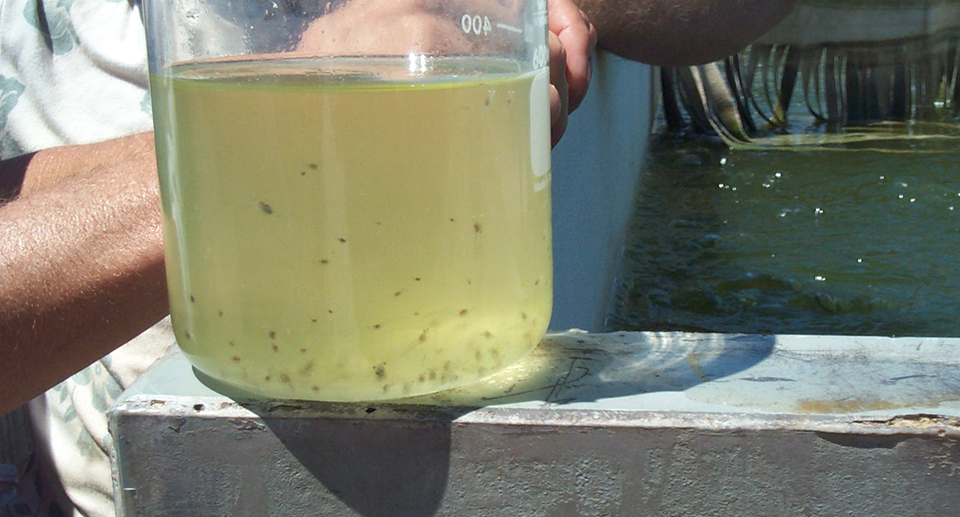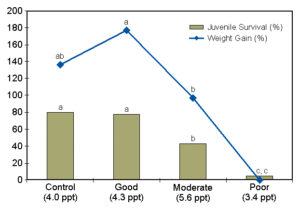Vannamei shrimp require a dietary source of potassium when reared in brackish water, but may not when reared in full-strength seawater

The culture of marine shrimp is primarily conducted in near-coastal areas using waters of estuarine and oceanic origin of 1-40 ppt salinity. However, numerous environmental, social, and economic advantages support the expansion of euryhaline shrimp and fish production away from coastal environments. Euryhaline animals can adapt to live in fresh water or seawater.
Because of the ready availability of Pacific white shrimp (Litopenaeus vannamei) postlarvae and their tolerance to low salinity, this species is being cultured in inland waters ranging 0.5 to 28.3 ppt in salinity. A number of farms have been in production for almost 20 years.
Unique problems
The culture of marine species in inland areas has great potential, as it could diversify agriculture, provide alternative species for existing aquaculture operations, and minimize the use of expensive coastal lands for aquaculture. However, because this is a relatively new field and the animals are maintained in a rather unique environment, a variety of unique problems must be addressed.
For shrimp, the problems unique to low-salinity inland systems include highly variable survival rates between ponds; mortality when the animals are subjected to salinities and/or temperatures within their range of tolerance in marine environments; and tail cramping, lethargy, and disoriented spinning behavior in the shrimp. Most of these problems seem related to physiological imbalances associated with the unique rearing environment.
Taking marine organisms from waters of high salinity to low salinity causes two major physiological stresses: the diffusive loss of salts from the haemolymph or blood to the medium and resultant uptake of water from the medium. The second stress can be particularly damaging. Tissues and cells take up water and increase in volume, and the resulting cell swelling impairs normal functions.
Current research and theory

Although data is limited and sometimes anecdotal, it appears the ionic balance of low-salinity inland water is sufficiently different from brackish water of oceanic origin to result in a number of problems. Fig. 1, which presents laboratory results in terms of growth and survival for juvenile shrimp reared in varying qualities of low-salinity water, demonstrates the variation of survival often seen with these water sources.
Results from a variety of studies have demonstrated correlations between the concentrations of certain potassium and magnesium ions in the water and shrimp survival. Farmers in areas of Alabama, USA, with low levels of these minerals in their water supplemented ponds with fertilizers high in these ions and found the supplements partially mitigated the problems. This resulted in a shift of survival from around 25 percent to 56 percent in commercial ponds.
Some farmers have also chosen to utilize feeds modified to contain enhanced levels of magnesium and potassium ions, sodium chloride, phospholipids, and cholesterol. Shrimp offered these diets reportedly had haemolymph serum osmolality values higher than those given a commercial feed without nutrient enhancement.
Dietary manipulation
The ion profile of saline water appears to be more important than its salinity in its effect on shrimp survival and growth. This is probably due to low concentrations of certain ions in low-salinity water that influence osmotic balance and mineral availability from the water, which in combination with low levels of the same minerals in the diet, result in insufficient levels to meet physiological requirements. Ionic imbalances due to osmotic stress or depletion of mineral reserves would account for some of the observed problems.
Given that aquatic animals can obtain minerals from food sources as well as the water, dietary supplements of selected minerals could facilitate better survival and growth of shrimp held in low-salinity conditions.
Earlier research by the first author conducted in outdoor tanks at a salinity of 10 ppt indicated that if a mineral premix was removed, growth fell by 11.8 percent, even in the presence of natural foods. When shrimp were held at 35 ppt and the mineral premix was removed, a 7.2 percent growth depression was observed.
In general, marine shrimp species reared in seawater do not require dietary sources of magnesium and potassium, which are high in natural seawater, whereas freshwater species reared in freshwater require dietary supplements. Penaeus monodon appear to require a dietary source of potassium when reared in brackish water, but may not when reared in full-strength seawater.
Salt supplementation aids fish
Research with red drums (Sciaenops ocellatus) and Asian sea bass (Lates calcarifer) has indicated positive benefits from the addition of salt to diets when the fish are reared at low salinities. Given this information, the supplementation of potassium, magnesium, and sodium chloride to practical diets is recommended and research into the influence of minerals on growth and survival in low-salinity water is warranted.
Preliminary trials by the authors adding sodium chloride supplements to shrimp diets have not resulted in enhanced performance. However, delivery of these and other water-soluble salts is technically more difficult in shrimp than fish due to shrimp’s feeding habits. In shrimp feeds, the leaching of these minerals must be addressed to ensure delivery after the pellets are immersed in water. Leaching losses can be reduced by using a variety of techniques to stabilize the pellets or less-soluble chelated or coated forms of the minerals.
Other factors
Dietary protein, fatty acids, and energy levels could also play important roles in influencing the ability of shrimp to cope with low-salinity environments. Several authors have postulated a relationship in shrimp between protein requirements and water salinity extremes. For example, in high-saline conditions, L. vannamei respond positively to increased dietary protein, while the protein requirements for P. monodon have been reported higher when they are reared in low-salinity water.
Free amino acids such as proline, glycine and alanine are involved in the intracellular osmotic regulation of penaeid shrimp in high salinities. However, in low-salinity waters, these free amino acids are not needed for osmotic balance but may be used for energy to maintain osmotic homeostasis. Therefore, an excess of protein or free amino acids such as arginine, which is phosphorylated as a high-energy derivative controlling the cell content of adenosinetriphosphate (ATP), may facilitate the adaptation to low-salinity environments.
Fatty acids, phospholipids
Osmoregulation is a membrane-mediated process for which enzymatic pathways and membrane permeability influence osmotic balance. Fatty acids and phospholipids, major components of biological membranes, are influenced by environmental parameters such as salinity and temperature.
A number of authors have reported salinity-induced changes in the fatty acid composition of fish cells. Gill lipid metabolism and ion transfer across fish gills are better understood than such functions across shrimp gills. In fish, salinity-induced changes in fatty acid cell composition have been reported, and one would expect the same in shrimp.
A review reported that the effects of phospholipids on stress response in L. vannamei are not fully known, but appear beneficial. Consequently, if specific diets for low-salinity culture of marine shrimp are to be developed, the effects of dietary lipids need to be better understood.
Carbohydrates
Although shrimp are more efficient at digesting proteins than carbohydrates, they do obtain a considerable proportion of their energy needs from carbohydrates. Such energy is essential for the maintenance of ionic pumps for ion exchange and other energy costs associated with osmoregulation.
Carbohydrates can play a direct or indirect role in providing energy for osmoregulation. Blood glucose levels fall when shrimp are exposed to extreme salinities, confirming the animals’ use of carbohydrates in osmotic adaptation. Hence, there may be advantages to looking at available energy sources which best provide energy for stressful culture conditions.
Conclusion
In general, the culture of shrimp in low-salinity inland waters is increasing with considerable success. However, a number of production problems appear to be associated with suboptimal ionic profiles of the water and the ability of shrimp to osmoregulate at a given life stage. As nutrient intake directly and indirectly influences shrimp’s tolerance of stress, the supplementation of selected minerals and lipids above the levels typically used in marine shrimp feeds appears warranted.
(Editor’s Note: This article was originally published in the June 2004 print edition of the Global Aquaculture Advocate.)
Now that you've finished reading the article ...
… we hope you’ll consider supporting our mission to document the evolution of the global aquaculture industry and share our vast network of contributors’ expansive knowledge every week.
By becoming a Global Seafood Alliance member, you’re ensuring that all of the pre-competitive work we do through member benefits, resources and events can continue. Individual membership costs just $50 a year. GSA individual and corporate members receive complimentary access to a series of GOAL virtual events beginning in April. Join now.
Not a GSA member? Join us.
Authors
-
D. Allen Davis, Ph.D.
Department of Fisheries and Allied Aquacultures
Swingle Hall 203
Auburn University
Auburn, Alabama 36849-5419 USA -
Imad P. Saoud
Department of Biology
American University of Beirut
Beirut, Lebanon
Tagged With
Related Posts

Health & Welfare
Ammonia addition enhances microbial flocs in nursery phase for Pacific white shrimp
In a study, “pre-fertilization” in the nursery phase of a biofloc system for shrimp was tested. The objective was to accelerate the biofloc formation to minimize ammonia concentrations, avoiding high peaks during culture.

Aquafeeds
Automated feeding systems in pond production of Pacific white shrimp
Results of this study show that automated feeding systems are significantly more efficient than hand feeding in shrimp production ponds and that increases in feed input, application of adaptive technology and training of people to maintain the feeding system must all be considered.

Aquafeeds
A look at protease enzymes in crustacean nutrition
Food digestion involves digestive enzymes to break down polymeric macromolecules and facilitate nutrient absorption. Enzyme supplementation in aquafeeds is a major alternative to improve feed quality and nutrient digestibility, gut health, compensate digestive enzymes when needed, and may also improve immune responses.

Responsibility
A look at various intensive shrimp farming systems in Asia
The impact of diseases led some Asian shrimp farming countries to develop biofloc and recirculation aquaculture system (RAS) production technologies. Treating incoming water for culture operations and wastewater treatment are biosecurity measures for disease prevention and control.


